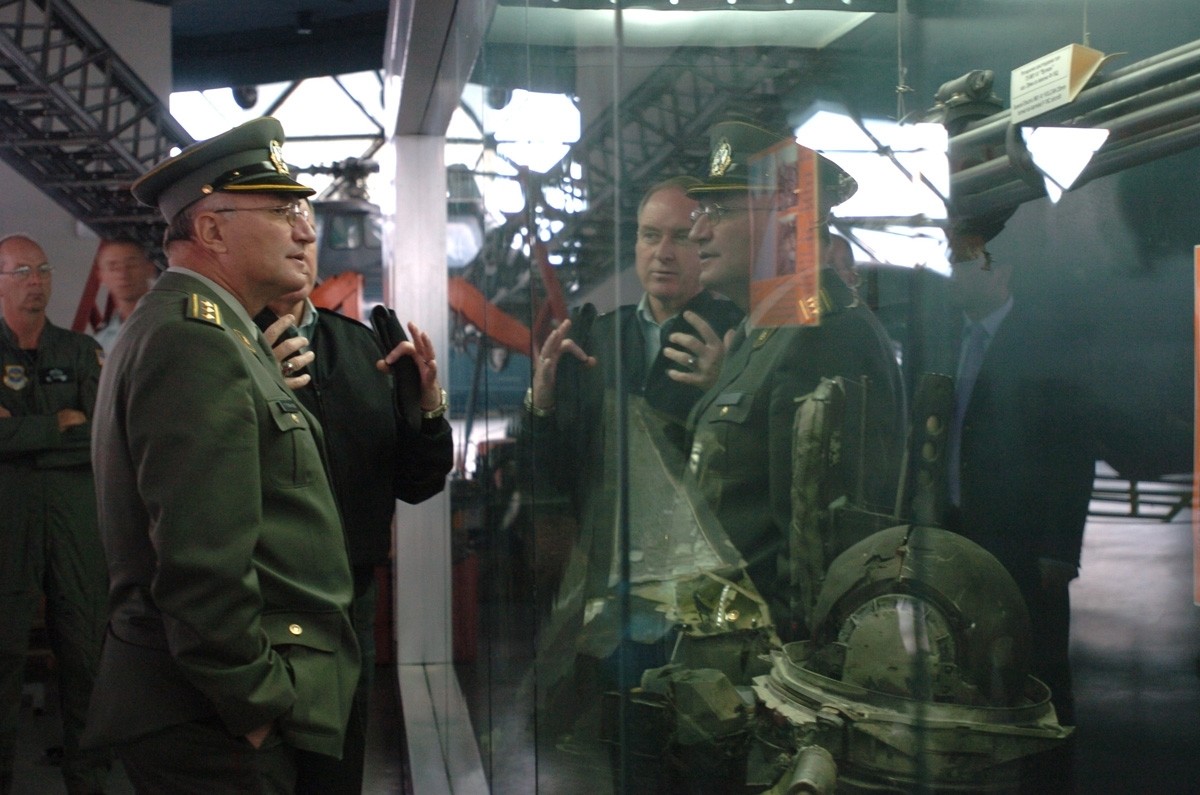
BELGRADE, Serbia (Army News Service, Nov. 2, 2007) - Despite the nine-hour red-eye flight, Maj. Gen. Gregory L. Wayt wore a warm smile as he descended from the Ohio Air National Guard KC-135 Stratotanker aircraft early Sept. 15 and embraced his good friend, Lt. Col. Gen. Zdravko Ponos, chief of Serbian Armed Forces.
Though just over a year had passed since their initial meeting, the two greeted one another as old friends, a term they often use to describe one another. In fact, both routinely refer to the National Guard Bureau's State Partnership Program, which brought the two men - and the two militaries - together, as the State "Friendship" Program.
"This is the culmination of the first year with a great program," Maj. Gen. Wayt said. "When we began a year ago, our goal was to make this partnership the best of all 56 state partnerships. There's no doubt we've done that. There's no other partnership that's done what we have."
Eight years had passed since Operation Allied Force and the NATO campaign that ended with the Serbian military's withdrawal from Kosovo.
So far, the Ohio National Guard and the Serbian Armed Forces have conducted 21 exchanges, four in the United States and the remainder in Serbia. The first exchange, in September 2006, sent Maj. Gen. Wayt to Serbia to meet with Lt. Col. Gen. Ponos and other senior military leaders to discuss ideas and expectations.
"At first, they were skeptical," Maj. Gen. Wayt said. "But from the beginning of this partnership, I talked openly with the press and Serbian Armed Forces. I told them this was going to be a mutual cooperation and we were going to learn from each other. Colonel G (Lt. Col. Goran Desancic) asked 'What are you going to learn from us'' I told him, 'Your soldiers are professionals. We understand and respect that. They've been in combat and they've had experiences our Soldiers haven't. We're going to learn from that.'"
The most recent exchange was the largest to date, with about 40 Ohio Soldiers and Airmen traveling to Serbia for a weeklong exchange of information and ideas between each country's special-forces, medical, joint-task-force, air and public-affairs personnel.
"This has truly been an historic week, and I'm really proud of it." Maj. Gen. Wayt said. "I asked Gen. Mlade Cirkovic, the Serbian Land Forces commander-in-chief, when the last time this many U.S. Soldiers were on Serbian soil. His recollection was World War II."
From the moment the delegation landed in Belgrade, personnel from each of the functional areas quickly met up with their Serbian counterparts. While the largest single delegation - a small unit exchange consisting of 16 Soldiers from Company B, 2nd Battalion, 19th Special Forces Group - immediately departed for southeast Serbia, the bulk of the delegation remained in the Serbian capital.
Throughout the week, delegation members in Belgrade conducted and received informational briefings, toured military and government facilities, shared ideas and began planning future cooperative efforts. The delegation also was treated to cultural tours and official events.
Maj. Gen. Wayt and a small delegation met with Cameron Munter, the U.S. Ambassador to Serbia, at the American Embassy Sept. 17 to discuss the Ohio-Serbia partnership. The program's stated goals, which include building relevant, long-term relationships and fostering trust and friendship between partners, are largely being met, Ambassador Munter said.
"There's no doubt this is an important program," he told Maj. Gen. Wayt. "We have to keep pushing ahead with a long-term vision. You guys have done terrific work."
Ohio's Belgrade-based delegation came together Sept. 20 and traveled about 140 miles southeast to Nis, home of the Serbian Land Forces Command headquarters as well as the command's Special Brigade, a joint tactical unit consisting of reconnaissance, anti-terrorist, parachute and diving elements.
Here, they witnessed the culmination of the weeklong small unit exchange between the two militaries' special-forces troops: a joint training display and exercise also attended by Serbian President Boris Tadic and other dignitaries.
The Nis-based troops had spent the previous week training on medical, weapons firing, survival techniques and parachuting, including a static-line jump from a Russian AN-26 cargo aircraft.
President Tadic presented each of the Ohio troops with the Serbian parachutist badge and Maj. Gen. Wayt presented the U.S. parachutist badge to the Serbian troops.
"Joint parachute training builds special camaraderie between Soldiers," said Maj. Larry Henry, Company B commander. "It was a great honor for my Soldiers to receive the Serbian parachute badge."
Two days later, the Ohio troops re-boarded the KC-135 to return home, chatting enthusiastically about their experiences, lessons learned and perhaps most importantly, the friendships and camaraderie developed over the preceding week. Soon after, Maj. Gen. Wayt received a text message from Lt. Col. Desancic.
"Sir thank you!" it read. "Yesterday during ceremony I saw Ohio flag and felt like I saw Serbian flag. Thank you for that feeling. Please convey regards to all of our friends."
(Staff Sgt. Kimberly D. Snow works for the Ohio National Guard Public Affairs Office.)

Social Sharing